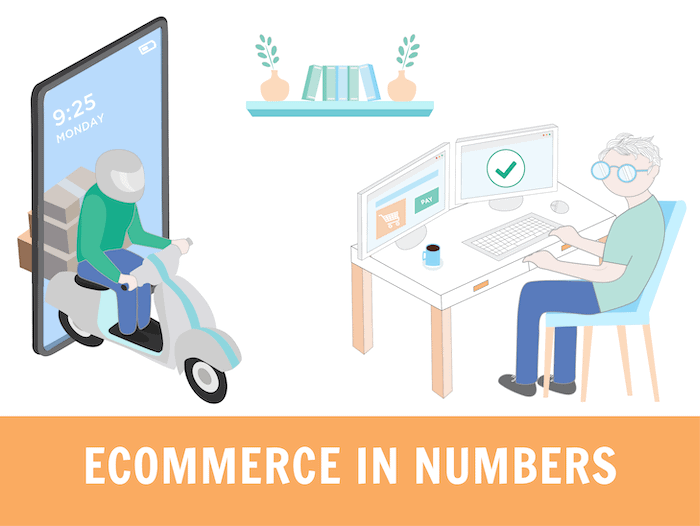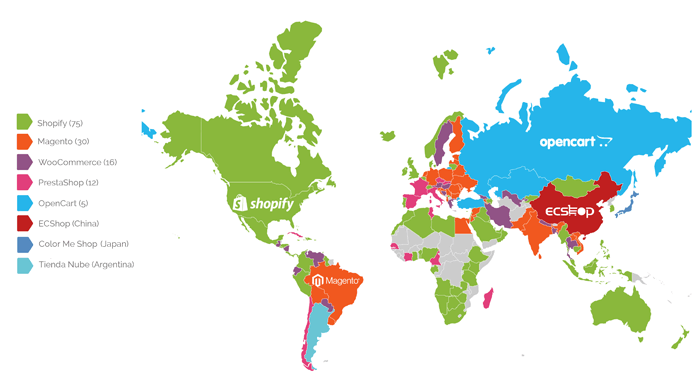If you run a small store, you may wonder why ecommerce statistics would be important to you.
The thing is, ecommerce is changing so rapidly, sometimes it helps to zoom out and study the larger trends.
So here’s what could be in it for you: ideas about your next marketing campaign, what to expect in terms of sales targets for the year, or new techniques that will help you boost conversions.
We’re going to cover a lot of ground today, so let’s get started! As you’ll see, the stats are grouped into the following categories:
The Global Ecommerce Market
Global online sales had been on a steady increase for the past few years, and the trend has been accelerated by the COVID-19 crisis. People stayed at home and couldn’t access retail shops. Online stores delivered. The global ecommerce market is still on an uptrend. In fact, in 2020, global ecommerce sales grew by 24% to $4.29 trillion – a marked increase from the 17.9% growth seen in the previous year, and accounting for 20% of all retail sales.
Ecommerce Will Soon Be The Most Common Way to Buy
According to some forecasters, 95% of all purchases will be done online by the year 2040. As mobile devices and even the IoT (Internet of Things) make it easier than ever to buy items on-demand, consumers sure seem to enjoy frictionless digital purchases.
This will contribute to the growing sum of ecommerce sales worldwide, set to reach $4.9 trillion in 2021, and culminate in a market of close to $6.4 trillion in 2024.
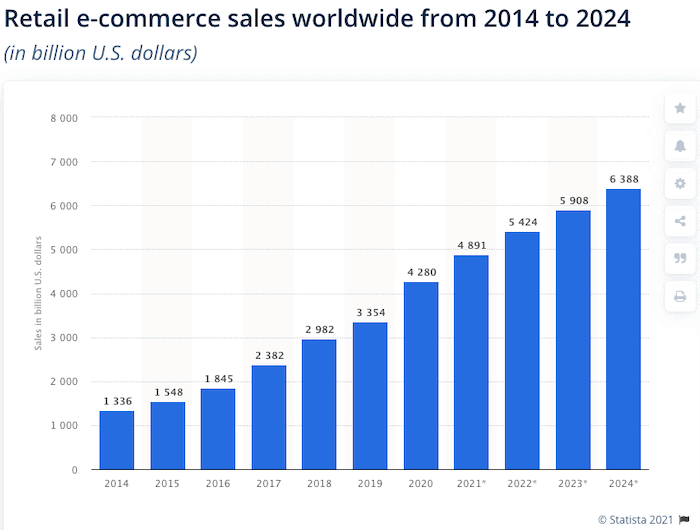
China Eclipses Every Other Market
In 2020, the top 10 largest ecommerce markets in the world, as compiled by eMarketer, were:
- China: $2,297 billion
- USA: $795 billion
- United Kingdom: $180 billion
- Japan: $141 billion
- South Korea: $110 billion
- Germany: $99 billion
- France: $73 billion
- India: $55 billion
- Canada: $39 billion
- Spain: $36 billion
In 2021, all are expected to continue growing, with India and China set to be the fastest-growing markets at 22% and 21% respectively. The only exception in the list is the U.K., whose ecommerce sales are expected to decline by 6.3%.
Interestingly, while most of the Western world is dominated by one retailing giant (more on that later), the enormous Chinese market is pretty much split between Alibaba (59% of the market), JD (17% of the market) and other retailers. As a side note, Alibaba went public on the US stock exchange in 2014 (and its stock has tripled since).
But the most interesting thing is that where the shop is located might not be so relevant anymore. This is because….
Shoppers Increasingly Buy Internationally
The ecommerce marketplace has increasingly porous borders. As delivery and transport logistics become more efficient than ever, a growing number of shoppers are looking further afield for their purchases.
According to a report by Nielsen (which has now been removed from their website), 57% of worldwide shoppers (on average) made a purchase from an overseas retailer in 2019. In 2020, this number increased to 68%, with China, the U.S. and the U.K. being the three most-shopped international marketplaces.
The Pandemic Effect
We briefly mentioned the impact of the COVID 19 pandemic on ecommerce over the past year. Bricks-and-mortar stores shutting shop, lockdowns, travel restrictions, and even panic-buying all had a part to play in the transformation ecommerce has undergone since the onset of the pandemic.
Statista reported a 62% dip in U.S. customers frequenting physical stores, while the number of online shoppers increased by 52%. Online grocery sales surged, with 74% of consumers preferring to visit online grocery platforms than go to the supermarket. Other ecommerce categories that saw rapid growth included hygiene products (specifically, disposable gloves), kitchen appliances, health and medicine, and home decor.
Sales for subscription and convenience services also skyrocketed in the early days of the pandemic, as shown in the chart below:
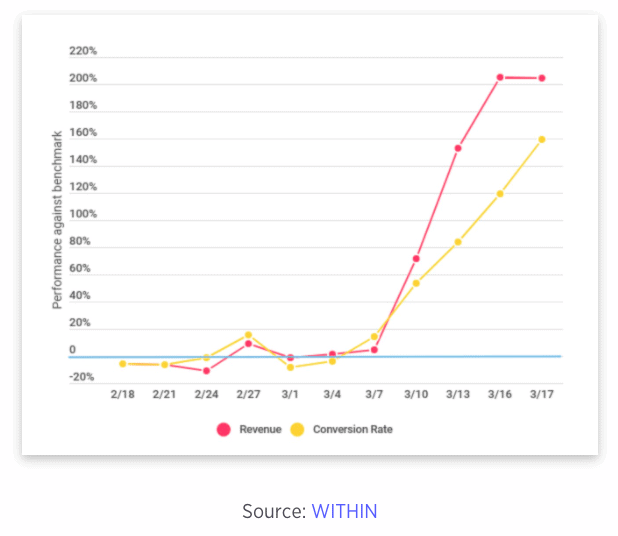
Even when lockdowns were lifted in the different countries, people continued to change their shopping habits. This included a 208% uptick in BOPIS (buy online pickup in-store) orders, and 85% of shoppers using curbside pickup. The same study found that 90% of consumers expected to continue using home delivery (rather than shopping in-store) over the following 6 months.
There are a few indicators that the boom in online growth will continue even after the pandemic is over. In the U.K., 46% of consumers expected to continue purchasing clothes and accessories online, ahead of any other product category. Electronics and entertainment (36%), and beauty products (33%), were the two other key categories that people planned to continue buying online.
One thing is clear: COVID has changed the way consumers shop, and perhaps even for the long run.
The Elephant In The Room – Amazon
Impossible to talk about global ecommerce without mentioning the retail giant Amazon. As a small business owner, you may have your gripes with it. But the truth is that Amazon sets the rules for the ecommerce game, and that you need to keep a close watch on what happens with Bezos’s behemoth.
Still One of the Big Players
While the two leading marketplaces (in terms of gross merchandise value) are Alibaba-owned Taobao and Tmall, Amazon comes in third with a not-so-insignificant GMV of $339 billion. While their sales in 2020 grew by 38% from the previous year, their Q4 actually saw the most significant growth, hitting $100 billion for the first time ever.
Prime Delivery Is Transforming Customer Expectations
One of the key selling points of Amazon is the Prime membership, which offers priority shopping along with a few other perks.
There are now 95M Amazon Prime members in the US alone, and this efficiency when it comes to receiving your packages is what your store will be up against. Delivery time is increasingly becoming the battleground where sales are won or lost, so how can smaller online stores compete against free next-day delivery?
Their Return Policy Is Also a Game Changer
Another advantage of controlling the delivery logistics and making that much money: you can be more flexible with your return policy.
According to RetailDive, 88% of shoppers want the ability to return a purchase, and 95% of them claim a smooth return process will turn them into repeat buyers. Amazon’s lax 30-day return policy is certainly influencing how your customers think about purchases – make sure you’re very clear in your own policies to avoid disappointing your customers.
Holiday Sales – Discounts and Special Deals
Unsurprisingly, the pandemic also had a huge impact on ecommerce sales during the holiday period, with Cyber Week 2020 breaking a slew of records. Shopify reported their most successful Black Friday and Cyber Monday ever. In the US, Cyber Monday was the biggest online shopping day in history, generating $10.8 billion in sales. And across the pond, the U.K. saw the biggest growth in Black Friday sales, up 146% year-on-year. Globally, online store visits increased by 21% during the event.
BFCM Is Growing Every Year
Black Friday and Cyber Monday are two of the biggest events in the online shopping calendar. BCFM sales have been increasing by around 19% year-on-year, and this trend continued in 2020. Adobe Analytics found that consumers spent $34.4 billion during Cyber Week – a 20.7% percent year-on-year increase.
- Amazon’s sales hit $4.8 billion during the Black Friday Cyber Monday weekend, and sales during the holiday period were up 50% year-on-year
- Shopify merchants generated over $5.1 billion in sales from the event – up a staggering 76% from last year
- Facebook also saw a 98% surge in orders as a result of Cyber Week, showing that social channels shouldn’t be ignored
Don’t Forget to Keep an Eye on Prime Day
Here we go again with Amazon, but as a small or medium online store owner, you’d be crazy to spend money on marketing in mid-October. Amazon is now forcing its Prime day discounts and sucking all the air out of online stores in early fall.
And it works: in 2020, the company reported $3.5B in sales, a nearly 60% year-over-year increase for Prime day profits.
Online Store Platforms
We’ve previously gathered some interesting statistics about Shopify and WooCommerce, and the numbers haven’t changed all that dramatically in 2021. But here are nevertheless some interesting statistics that help understand where they fit within the larger picture of online store platforms.
WooCommerce Still Rules Ecommerce Websites
It covers a whopping 92% of the plugin market (all categories combined), which is impressive, even when you consider that WordPress runs pretty much a third of all websites in the world. But considering that Automattic, the WordPress.com parent company, owns WooCommerce, this is a bit less surprising.
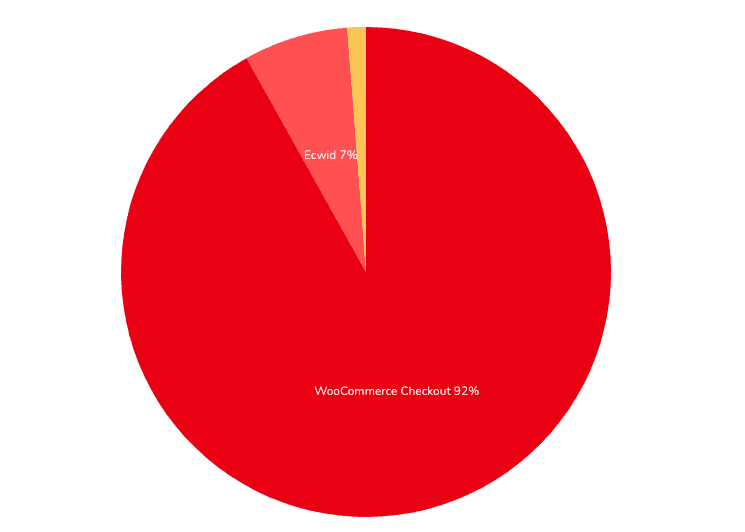
If you’re curious about the second leader, Ecwid, it’s a plugin that lets you add an online store module to any website. It’s interesting to see how popular it is, considering it’s not exactly a household name, unlike, say, Shopify.
If we take a look at the entire ecommerce platform market, the numbers tell a very different story – however, WooCommerce is still the undisputed leader, with over a quarter of the top 1 million ecommerce websites built using the plugin. Shopify comes in at a close second.
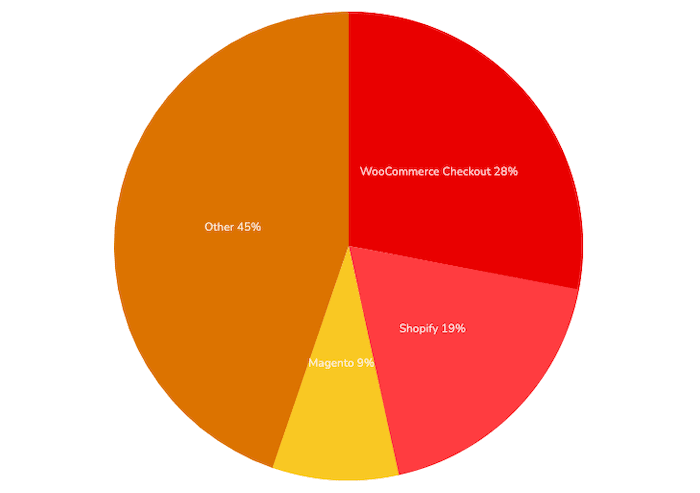
Shopify – Taking The World By Storm?
According to our research, Shopify was the only provider to be trending in every continent, with particular strongholds in North America, Africa, Australasia and Southeast Asia.
While the online store platform was traditionally focused on the US and Canada (which subsequently extended to other English-speaking countries), in 2018 the company began aggressively targeting the rest of the world.
There are now 6 new languages available on the Shopify platform: French, German, Spanish, Italian, Brazilian Portuguese, and Japanese. Shopify Payments, (a killer selling point if you want to avoid paying more on card transaction fees), is now also available in more countries, and hundreds of currencies are available already.
Oh, also, their stock rose up 270% amidst the pandemic – while sales in Q4 of 2020 grew 94% from the comparable quarter the previous year.
Magento Delivers Ecommerce Solutions For The Big Brands
This won’t come as a surprise to anyone, but Magento is still the number one ecommerce solution for big name brands in a variety of verticals, such as Olympus, 3M, Nike or Ford.
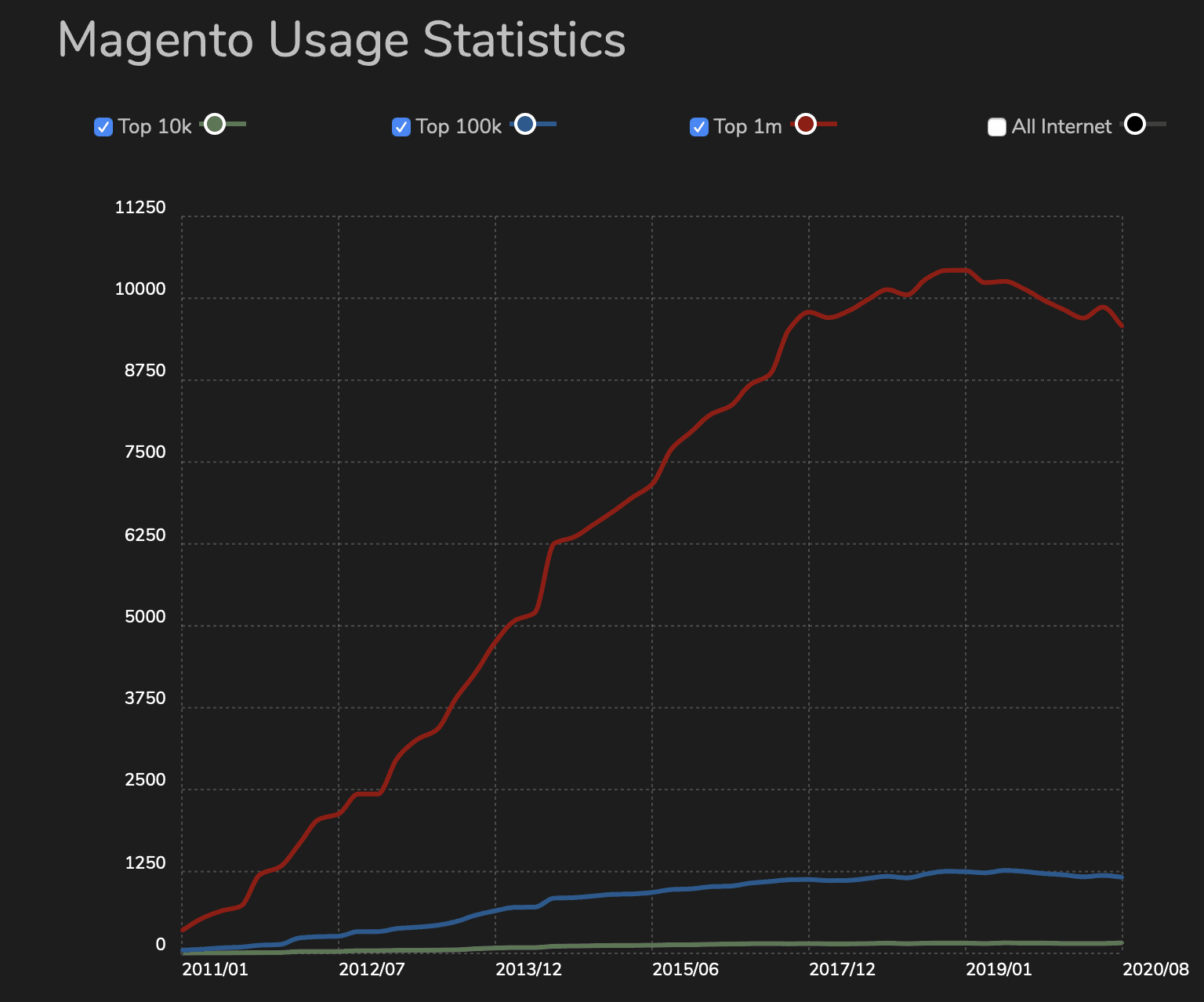
It’s unlikely any of these companies would suddenly switch to Shopify after building a whole infrastructure for Magento, but there has nevertheless been a noticeable decline in usage between 2019 – 2020.
Mobile Sales – Don’t Miss Out
So far, we’ve already established that consumers are purchasing online more than ever. But what about their favoured devices?
Well, it turns out that smartphones are increasingly used for online shopping. And neglecting these devices could have terrible consequences for your store.
Nearly Half of Purchases Come From Mobile
According to OuterBox, mobile traffic became as prevalent as desktop traffic back in 2015. In 2020, a whopping 43% of holiday sales were made directly from smartphones.
A Poor Mobile UX Will Kill Your Store
Another crazy statistic, 62% of users who have had a bad experience with mobile purchases will look elsewhere. At least that’s according to Google’s own research, which you can read about here. Our own research shows that long website loading times can be especially problematic on mobile devices.
Mobile Site or App? Why Not Both!
When we talk about mobile purchases, we should also mention the difference between in-app purchases and mobile sites or progressive web apps (PWAs).
According to Google, it doesn’t matter so much whether you sell via a dedicated app or use an optimized mobile site. The lines are increasingly blurry between the two, and the key takeaway is to ensure that your site loads fast, that the user experience is top-notch, and that the content is useful.
Marketing Channels – How Should You Support Buyers
There’s a reason brick and mortar shops still do well: customer service and sales assistants. They’re there to help buyers, guide them (and yes, sometimes upsell or cross-sell products). How should you do it in the digital age?
Instagram is A Serious Discovery Tool
Take the stat with a pinch of salt because it comes straight from Facebook, but 83% of people say Instagram helped them discover new products and services.
It certainly aligns with what other marketing companies have found, as GlobalWebIndex says 70% of Instagram users are more likely to make online purchases on their mobile devices. Similarly, 44% of Instagram users have claimed that they used social media to conduct brand research. No wonder the engagement between users and brands is 10 times greater on Instagram than Facebook.
The Power of Messaging Apps
Live chat is going strong for online stores. According to Facebook themselves, 61% of US consumers had messaged a business directly in the 3 months prior to the study. You can’t beat the speed, efficiency and convenience of talking to a business directly from your phone or desktop.
Even more interesting is that engagement rates through Facebook Messenger seem to be a lot higher than through other channels. Generating a 98% open rate and 44% click-through rate, Facebook Messenger significantly outperforms email and even its own News Feed.
Live Chat and ChatBots for Automated Response
While chatbots are more useful for support than actually buying something, the intelligent customer experience platform Narvar reports that 29% of US online shoppers use them for purchases.
If you have never set up a live chatbot before, it’s actually a lot easier than you may think.
Email Marketing is Still King for Cart Recovery
According to SaleCycle, the global cart abandonment rate in 2020 was 81%. That’s a lot of orders that aren’t completed! And the three key reasons are a high delivery fee, too much friction when you need to create an account, or a complex checkout process. These were the top answers given to Baymard institute, showing once again that a frictionless checkout experience is primordial.
But how do you recover these lost carts? Email marketing is still the best method. According to Moosend, (who, we should acknowledge, could be biased) the open rate for abandoned cart emails reached upwards of 40%!
Customer Reviews
As our research has shown, pretty much all online shoppers (approx. 95%) read reviews. However, if your website has a section for customer reviews you need to make sure there is something to show as 92% of customers hesitate to buy if there are zero reviews. We could even find out how many reviews you need: 5 or more reviews make all the difference when deciding to buy or not to buy.
Online Fraud – Ecommerce’s Dirty Secret
Let’s end with statistics on an unfortunate topic: the growing problem of fraud. Seeing how it’s a growing concern, chances are you’ve had to deal with fraudulent users at some point or another. Here’s where it’s headed according to the numbers.
Chargebacks Remain Costly
The most common type of e-commerce fraud is chargeback fraud, which happens when a customer tells their card company they did not make a purchase. It’s usually a lie, which gives them a free item, their money back, and ends up costing you money, as you have to foot the chargeback fees. This is expected to cost online retailers $130B by 2023.
In fact, it’s estimated that every dollar lost to fraud ends up costing organizations up to $3 in costs.
Keep an Eye on Return Fraud
Return fraud is also a growing problem, and one that many retailers blame on Amazon’s lax return policies (see above for more info). The online giant makes it easier than ever to return items, which some shoppers abuse for their own purposes (wardrobing, for instance, where they buy clothing, wear it once, with the intention of returning it later). 1 in 5 UK shoppers admits to having done it. This explains in part why return rates continue to grow (expected to reach 10% by 2022 according to Deloitte)
Account Takeover is Also on the Rise
An account takeover or ATO attack happens when fraudsters use your customers’ accounts. They can either find the login details via phishing or from data leaks bought on the darknet. Either ways, it looks bad for online stores, creating a loss of trust, not to mention time and effort in customer support.
While this used to be a big problem in online gaming and digital wallets, we’re seeing more and more attacks on online stores, which cost retailers $9B in lost profits in 2019. In 2020, ATO attacks on physical e-commerce (online stores that sell physical goods) rose by a staggering 378%, with many fraudsters exploiting the increasing availability of ‘buy online pickup in-store’ and ‘buy online return in-store’ services.
Ecommerce Statistics of 2022 – The Key Takeaways
So what can we conclude after poring over the data? Here are six actionable tips you could use for your own ecommerce:
- Make user experience as seamless as possible. Shoppers will turn to your competitors at the first sign of an obstacle, from a complex checkout to strict return policy.
- But don’t be too care-free: fraudsters are increasingly targeting small online stores, so don’t think your size will allow you to stay under their radar.
- Multichannel communication is the way to go: ideally, you need to master email marketing, implement chatbots and ensure your business is easy to communicate with, whichever way customers like to.
- Offer flexible delivery options: Many customers are still reluctant to spend too much time in physical stores, so if it’s possible for your store, explore offering options like BOPIS and curbside pickup
- Stay positive: if there’s one silver lining to all the obstacles faced by online store owners, it’s that ecommerce shows no sign of slowing down. If you can find your niche, sell great stuff and keep customers happy, you’ll put all the odds in your favour.
2020 was a tumultuous year, and while we’re yet to see how the rest of 2021 will pan out, the past year has shown that consumers need the security and reliability of online shopping more than ever. So, here’s to being cautiously optimistic that this trend will continue, both this year and beyond.
THE BEHIND THE SCENES OF THIS BLOG
This article has been written and researched following a precise methodology.
Our methodology